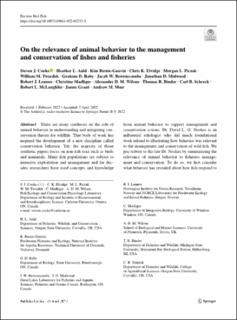On the relevance of animal behavior to the management and conservation of fishes and fisheries
Cooke, Steven J.; Auld, Heather L.; Birnie-Gauvin, Kim; Elvidge, Chris K.; Piczak, Morgan L.; Twardek, William M.; Raby, Graham D.; Brownscombe, Jacob W.; Midwood, Jonathan D.; Lennox, Robert; Madliger, Christine; Wilson, Alexander D. M.; Binder, Thomas R.; Schreck, Carl B.; McLaughlin, Robert L.; Grant, James; Muir, Andrew M.
Peer reviewed, Journal article
Published version

Åpne
Permanent lenke
https://hdl.handle.net/11250/3049364Utgivelsesdato
2022Metadata
Vis full innførselSamlinger
- Publikasjoner fra CRIStin - NINA [2397]
- Scientific publications [1423]
Sammendrag
There are many syntheses on the role of animal behavior in understanding and mitigating conservation threats for wildlife. That body of work has inspired the development of a new discipline called conservation behavior. Yet, the majority of those synthetic papers focus on non-fish taxa such as birds and mammals. Many fish populations are subject to intensive exploitation and management and for decades researchers have used concepts and knowledge from animal behavior to support management and conservation actions. Dr. David L. G. Noakes is an influential ethologist who did much foundational work related to illustrating how behavior was relevant to the management and conservation of wild fish. We pay tribute to the late Dr. Noakes by summarizing the relevance of animal behavior to fisheries management and conservation. To do so, we first consider what behavior has revealed about how fish respond to key threats such as habitat alteration and loss, invasive species, climate change, pollution, and exploitation. We then consider how behavior has informed the application of common management interventions such as protected areas and spatial planning, stock enhancement, and restoration of habitat and connectivity. Our synthesis focuses on the totality of the field but includes reflections on the specific contributions of Dr. Noakes. Themes emerging from his approach include the value of fundamental research, management-scale experiments, and bridging behavior, physiology, and ecology. Animal behavior plays a key role in understanding and mitigating threats to wild fish populations and will become more important with the increasing pressures facing aquatic ecosystems. Fortunately, the toolbox for studying behavior is expanding, with technological and analytical advances revolutionizing our understanding of wild fish and generating new knowledge for fisheries managers and conservation practitioners.
Tidsskrift
Environmental Biology of FishesOpphavsrett
© 2022 The AuthorsBeslektede innførsler
Viser innførsler beslektet ved tittel, forfatter og emneord.
-
Intensity of space use reveals conditional sex-specific effects of prey and conspecific density on home range size
Aronsson, Malin; Low, Matthew; López-Bao, José Vicente; Persson, Jens; Odden, John; Linnell, John Durrus; Andrén, Henrik (Journal article; Peer reviewed, 2016) -
Vandringsløsninger for fisk i regulerte vassdrag – oppsummering av resultater fra forskningsprosjektet SafePass
Forseth, Torbjørn; Museth, Jon (NINA Rapport;1861, Research report, 2020)Forseth, T. & Museth, J. 2020. Vandringsløsninger for fisk i regulerte vassdrag – oppsummering av resultater fra forskningsprosjektet SafePass. NINA Rapport 1861. Norsk institutt for naturforskning. I denne rapporten ... -
The NINA scale. A New Approach to Measuring Environmental Attitiudes
Kaltenborn, Bjørn P.; Wold, Line C.; Keller, Rose; Krange, Olve; Aas, Øystein (NINA Rapport;2008, Research report, 2021)Kaltenborn, B.P., Wold, L.C., Keller, R., Krange, O. & Aas, Ø. 2021. The NINA Scale – A New Approach to Measuring Environmental Attitudes. NINA Report 2008. Norwegian Institute for Nature Research. The purpose of this ...
